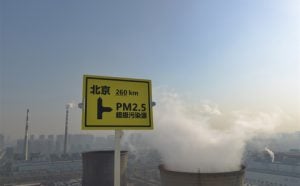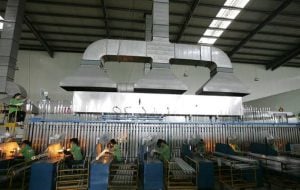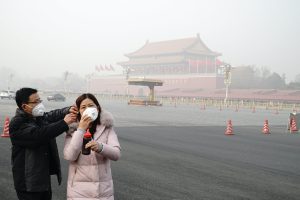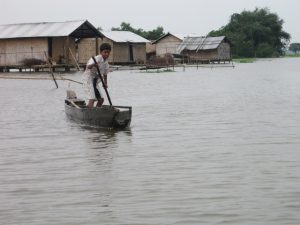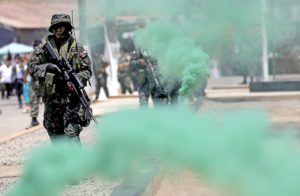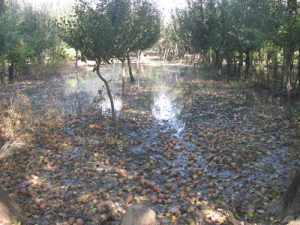The past few months has seen a marked increase in the number of ‘blue sky days’ in the Chinese capital, during which the sun’s rays were able cast their glow on a city that too often is shrouded in sickly grey smog.
For the past several years, winter and early spring in Beijing has been characterised by regular, prolonged bouts of choking smog, reducing visibility and blocking out the sun, with air quality reaching crisis levels that prompted a strong response from central and city governments.
It’s scarcely surprising that the improving air quality has been warmly welcomed by the capital’s residents, who have taken to social media in droves to share photos of blue skies that many city-dwellers in the western world now take for granted.
So what’s behind the cleaner air, and is it the start of a longer-term improvement?
Experts say it’s hard to tell as the vagaries of the area’s weather can make a major difference to smog levels.
“Windier conditions have played a big role,” says Ma Jun, a Chinese environmentalist, the head of Beijing-based Institute of Public and Environmental Affairs and the entrepreneur behind the ‘Blue Map App’ that enables residents of Chinese cities to check on pollution levels.
“In April and May the winds have blown in from the north, which has helped to disperse smog or prevent it from building up in the first place. But the precise role that weather plays in Beijing’s smog levels requires further research”, he says.
That is not to say that the improvement in air quality means that the air is healthy. On many days, even when blue skies are the backdrop to the Beijing skyline, air quality levels are well above the national standard.
Data from Beijing municipality’s environment bureau shows that that PM2.5 levels fell almost 20% in the first quarter of this year compared with 2014, a period when windy weather wasn’t as prevalent as April and May.
“This is definitely good news for the public who demand to breathe clean air. However, the current average is more than two times that of China’s national standard (35ug/m3), so Beijing still faces big challenges to curb air pollution,” says Yuan Fang of Greenpeace.
One foreign expert on Beijing’s air quality said that an improvement could only be evaluated properly on a much longer-term basis.
“For example, in the US, air quality standards are measured as a three-year average, although in the case of the first quarter in Beijing I’d be surprised if the shutdowns of coal-fired power in the city haven’t had an impact,” the expert said, requesting anonymity.
A milder winter meant that demand for heat powered by the burning of coal in local boilers was lower, while accelerated shutdowns of the city’s coal-fired power plants and antiquated district heating units was also likely to be behind the improvement, says Greenpeace’s Fang.
But at times over the past few months the smog has returned, just less often than last year or in 2013.
Conflicting priorities
“Emissions of harmful particulates are still far too high and combating this will require much closer regional co-ordination,” says Ma Jun, pointing to moves at the highest level to force closer co-operation between the relatively prosperous megacities Beijing and Tianjin with neighbouring but poorer and heavily-industrialised Hebei.
In Hebei, which has typically has the worst smog in China, air quality has shown scarce improvement as local officials have been slow to make the large-scale shutdowns of steel plants and other industrial facilities that burn coal.
Building trust between Beijing municipality and Hebei won’t be easy however, given the conflicting priorities of an increasingly post-industrial and services-orientated capital aiming at ‘World City’ status and the 2022 Winter Olympics, and a province that remains reliant on coal-intensive industries to provide jobs.
And Beijing is responsible for much, maybe most of its smog, prompting further shutdowns of coal-fired power within the city’s boundaries, restrictions on coal use in district heating and increasing curbs on car journeys and old, polluting vehicles.
Migratory smog
Figures released earlier this year by China’s Ministry of Environmental Protection suggested that car use was responsible for over one-third of particulate emissions in Beijing, with another third coming from the burning of coal in a city that is now home to an estimated 20 million people.
Particulate matter blown in from Hebei and other surrounding areas is responsible for the final third of Beijing’s airborne pollution, the research says, although a precise breakdown of where Beijing’s smog comes from has always been difficult, say other observers.
But it is these emissions from outside the city limits that can turn Beijing’s air from very bad to downright awful, and migratory smog from Hebei’s heavy industry is increasingly a source of anger in the streets of the capital.
“People have very little trust in the industrial sector… When people experience a period of blue skies in Beijing they get used to it, but then the return of smog reminds people that this isn’t a problem that will go away soon or be solved easily,” Ma Jun points out.

